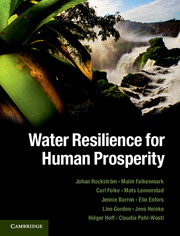Book contents
- Frontmatter
- Contents
- List of Contributors
- Preface
- Introduction to the book
- Acknowledgements
- Part I A new perspective
- Part II Living in a human-dominated world
- Part III Food production globally: in hotspot regions and in the landscape
- Part IV Governance and pathways
- 8 Governance for navigating the novel freshwater dynamics of the Anthropocene
- 9 Pathways to the future
- Glossary
- Index
- References
8 - Governance for navigating the novel freshwater dynamics of the Anthropocene
from Part IV - Governance and pathways
Published online by Cambridge University Press: 05 August 2014
- Frontmatter
- Contents
- List of Contributors
- Preface
- Introduction to the book
- Acknowledgements
- Part I A new perspective
- Part II Living in a human-dominated world
- Part III Food production globally: in hotspot regions and in the landscape
- Part IV Governance and pathways
- 8 Governance for navigating the novel freshwater dynamics of the Anthropocene
- 9 Pathways to the future
- Glossary
- Index
- References
Summary
The focus of this chapter is the transformation of water governance required for living with the new water dynamics in the Anthropocene, and the expansion needed from the conventional blue water perspective. It discusses the integrated governance and management required for resilience building, including desirable landscape patterns of ecosystem services, and how to overcome past governance failures from a sustainability perspective. It stresses that resilience building comprises precautionary management for stewardship of precipitation, the need for cross-sectoral integration, and the overcoming of inertia of rigid or dysfunctional bureaucracies, making good use of emerging windows of opportunity.
The Anthropocene era: novel governance and management
People and societies are embedded parts of the biosphere and depend on its functioning and life-support systems. However, in the Anthropocene era, humanity is also shaping the biosphere globally (Steffen et al., 2007; Steffen et al., 2011) in what are referred to as social–ecological systems (Berkes and Folke, 1998). When the functioning of these intertwined systems is altered, there is a high risk that adaptations to local conditions, such as the optimisation of agriculture to historical precipitation regimes, will no longer be sufficient.
The previous chapters have demonstrated that water plays a central role as the bloodstream of the biosphere, connecting people and places, affecting livelihoods and influencing social–ecological resilience. Clearly, we are operating in a new terrain in which truly integrated, complex systems interact at multiple scales from the local to the global, and we are confronted with turbulent times (Folke et al., 2011; Walker and Meyers, 2004).
- Type
- Chapter
- Information
- Water Resilience for Human Prosperity , pp. 226 - 249Publisher: Cambridge University PressPrint publication year: 2014



